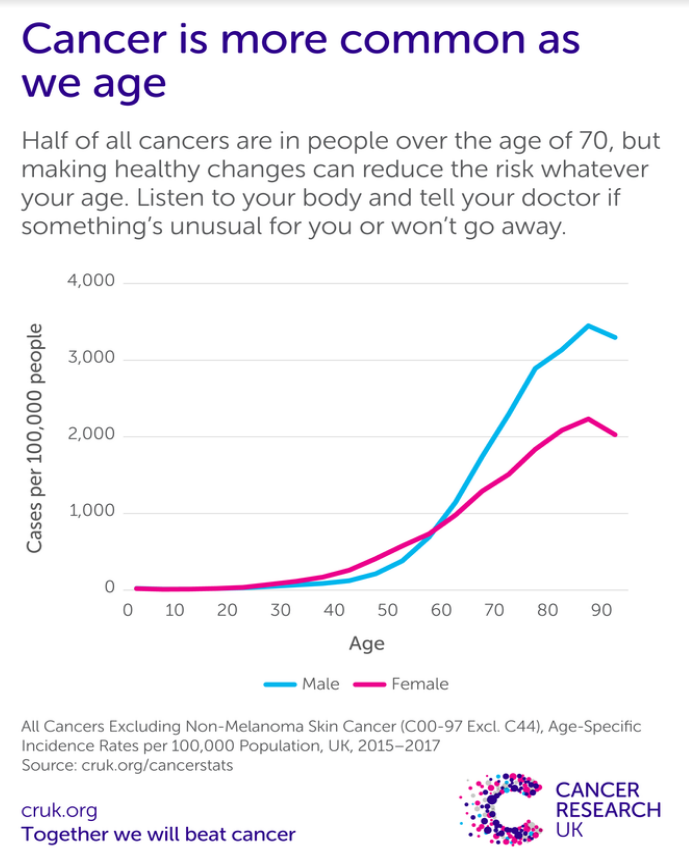Age: The Clue to the Centrality of the Immune System to Cancer
Executive Summary
- The immune system is central to understanding why people get cancer.
- Why does the medical establishment discuss it so little?

Introduction
A major clue to how cancer functions and why it occurs is observing the increasing incidence of cancer that comes with age. This is related to what happens to the immune system as we age.
The Immune System’s Decline With Age and The Increase in Cancer
Let us review this quote on the topic of immunotherapy treatments from the website of the Cancer Center.
When it (the immune system) doesn’t recognize cell changes associated with cancer as dangerous, those cells proliferate, form tumors, and sometimes spread throughout the body. When cancer eludes the immune system, it’s almost as if the immune system is asleep on the job. Immunotherapy wakes up the immune system and tells it that those cancer cells are a dangerous threat. Once the immune system recognizes the threat, it activates and releases T-cells to attack the cancer cells.
There is a problem with this explanation, which is the question of “why” this pattern of cancer exists.
The Cancer Center explains that immunotherapy drugs provide extra information to the immune system. However, this explanation is strange, as the immune system has been finely tuned to identify and kill cancerous cells. The following quote is a good explanation of this.
But if the immune system is so strong and sophisticated, why does it fail so often in fighting cancer? The short answer: because the cancer overpowers it. “I tell my patients that if we didn’t have an immune system, we’d all get cancer,” says Alan Tan, MD, Medical Director of Hematology and Immunotherapy and Medical Oncologist and Hematologist at our hospital “There’s a fine balance between the burden of cell mutation and how well your immune system can fight it off.
It is always alert to threats. It’s when the immune system is overwhelmed by a tumor that it fails to identify and respond to the threat.”
The process works well when young people only seem to fall into dysfunction later in life and under certain conditions.
The Core Function of the Immune System and Quality Control for Cell Division
This video explains how cell division or mitosis works. The term used in the video is “checkpoints,” however, this is translated into the more general term “quality control.”
All humans begin their lives as a product of cell fusion, where one’s 1/2 of one’s parents’ DNA is fused to create a completely new cell. However, after this brief activity, all growth and maintenance is a product of cell division or mitosis.
This quote from Healthline provides an idea of how many new cells a human body has to create or divide from preexisting cells daily.
A good start is to look at the number of RBCs that are produced each day, as RBCs are the most abundant type of cell in the body. RBCs live for about 120 days, at which point they are removed from circulation by macrophages in the spleen and liver.
At the same time, specialized stem cells are replacing the dead red blood cells at roughly the same rate.
The average body makes about 2 to 3 million red blood cells every second, or about 173 to 259 billion red blood cells per day.
To see how strongly cancer correlates with age, let us review the graph from Cancer Research.UK.

There is a strong inflection point at 60 years of age for both women and men, with the inflection being significantly higher for men. This is reinforced in the following quotation from Our World in Data.
Almost half – 46% in 2017 – of all people who die from cancer are 70 or older. Another 41 percent are between 50 and 69 years old – so that 87% of all cancer victims are older than 50 years.
The distribution of deaths across the age spectrum has changed notably since 1990. The share of deaths which occur in those aged over 70 has increased by 8 percentage points, whilst the share in those aged 50-69 and 15-49 has fallen.
Collectively, children and adolescents under 14 years old account for around one percent of cancer deaths — this equates to around 110,000 children per year.